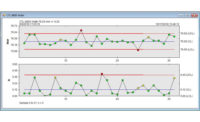The goal of performance management, as defined by the United States Office of Personnel Management, is “improving organizational effectiveness.” Performance management application, however, depends on both the industry and the methodology being applied.
Business performance management (BPM), also known as corporate performance management (CPM) or enterprise performance management (EPM), is how most operational managers in the manufacturing sector go about improving their organization’s effectiveness. Through BPM, an organization’s performance is evaluated based on the achievement of one or more pre-selected goals from an established set of management and analytic processes.
While BPM methodologies vary—Lean, BP Trends, Six Sigma, Hammer, and Rummler-Brache are just a few examples—one of the most popular in recent years has been Lean Six Sigma, a systematic method that combines Lean and Six Sigma strategies for eliminating waste throughout the production cycle. Today, Lean Six Sigma spinoff methods are gaining traction, as well as more holistic approaches that favor collaboration over the more traditional isolation of business units.
Enter Integrated Performance Management (IPM), a process tailored from Lean Six Sigma concepts that centers on integration of business silos as the key to operational agility.
Quality spoke with Chris Alger, managing director of BDO Consulting and member of BDO’s Manufacturing & Distribution practice, to learn more about the benefits of IPM and why, as Alger puts it, “turbulent times” call for a more integrated response.
For readers who aren’t familiar, could you give a brief overview of IPM and how it came to be?
Integrated Performance Management (IPM) represents the tight coupling and collaboration of traditionally siloed or loosely related business activities associated with strategic planning, investment decision-making, budgeting and forecasting, and performance reporting/management.
IPM initially evolved organically through advances in the individual silos. For example, budgeting as an isolated event eventually morphing into ongoing budgeting and forecasting (e.g. Rolling/Dynamic Forecasting) forces this capability squarely into the performance management cycle. Another example is asset intensive businesses. Over the years, there has been a strong push to better predict and measure the business impact of investments in the form of ROI or top-line growth effects. Businesses realized that simply performing these critical business activities resulted in high-quality, but often, sub-optimized business activities. Lean principles of waste reduction, value stream mapping, and flow in conjunction with the tried and true Continuous Improvement loop or wheel provide strong conceptual precedent for the barrier and silo removal focus of Integrated Performance Management.
As a result of these trends and ever-increasing market volatility, the performance management cycle is starting to be evaluated from a process and tools perspective, the same way any company assesses other end-to-end processes to achieve the full benefits of efficiency and effectiveness while driving improvements in management agility.
What are the steps of the IPM process cycle? How does each step build upon the next?
The Integrated Performance Management cycle can be thought of in the context of a broader planning framework that encompasses both Strategic Planning elements as well as more Tactical Planning elements including IPM.
IPM is typically comprised of four main elements. Though some authors refer to these elements by different names, ultimately the IPM components revolve around these common outcomes.
Operating Strategy
The operating strategy is the starting point of the cycle. It defines the critical elements of the overall business strategy while incorporating into the strategy the operational goal-setting of top- and bottom-line performance over an 18- to 24-month time horizon. The operating strategy will model business performance from a Profit & Loss, Balance Sheet and Cash Flow perspective and communicate to the business operators their investment, resource and organizational accountability expectations relative to desired, measurable outcomes. This information directly guides decision-making relative to tactical target setting, as well as justification and timing of actionable capital investments and projects necessary to achieve the overarching strategic performance improvement targets.
Tactical Improvement Projects
Tactical Improvement Projects cascade from the key points of the operating strategy and translate goals into investment and action. These actionable performance improvement targets, projects and associated investments are converted into both conservative and aggressive performance objectives that, when achieved, will ultimately drive the improvement to forecasted top-line and/or bottom-line performance. Accountability for achieving these performance targets should always cascade into the relevant operational organizations that are responsible for realizing the targets. Similarly, the realization of these targets should be linked directly to management rewards and recognition.
These cascaded targets and their associated improvement initiatives help management prioritize and communicate the desired outcomes of improvement opportunities to the line operations managers tasked with executing against these targets. The resulting investment projects, resource requirements, goals coupled with their relative timing are critical inputs into the budgeting and forecasting activities below.
Budget and Forecasts
Not surprisingly, the budget should reflect the company’s most current operational realities, taking into account the impact and expected timing of the overlaid targeted improvements. Subsequently, the leading practice of leveraging the most recent market and operating insights into forecasts (e.g. rolling forecasts or dynamic planning) facilitates alignment, efficiency and relevance in both the budgeting and forecasting processes. Bottom-up, 18- to 24-month rolling forecasts provide management with a powerful tool to triage and exploit the opportunities of a dynamic business environment. Budgets and associated forecasts should also be developed at a level of detail reflecting appropriate controllability and expenditure risks while optimizing the number of line items (accounts) and planning levels. For better decision support, use driver-based “what-if” modeling to extrapolate the business impact of financial, operational or capital projects. At any point in time, current forecasts/budgets linked to operational and marketplace realities should represent the single best version of future expectations that can help guide business decision-making and communication (internally and externally) in a rapidly changing environment.
Performance/Feedback
When provided effectively, timely performance reporting and feedback deliver comprehensive information tailored to the needs of specific performance evaluators and decision-makers. Performance feedback encompasses both current financial and future operational forecast information against existing forecast and targets, and also includes a balance of other key performance indicators (KPIs) that provide additional internal and external insights into the forces influencing performance and future priorities.
The performance management process of the IPM cycle focuses on evaluating markets and operations against forecast, assessing projects against targets, analyzing KPI variances and then deciding to adjust the operating strategy (if appropriate), leading to revisions of the performance objectives and targets to reflect the new realities of the operating environment and the marketplace.
If the IPM cycle is truly integrated, designed efficiently, and focused on leveraging cost-effective productivity and decision-support tools, the cycle can facilitate management agility to a level consistent with business volatility. Rather than making each decision event a time-consuming data gathering and analytic exercise—creating management distractions and operational disruption—IPM is able to place 80 percent of the decision support information in your hands within hours, as opposed to days or weeks. This reduces the decision cycle time while freeing up management to support more value-added operational and marketplace demands.
How might manufacturers go about integrating these steps into the workplace?
The beauty of IPM is that each of its basic components (operating strategy, tactical improvement, budgeting & forecasting and performance management) is already a critical activity in most, if not all, manufacturing businesses of scale and complexity. The “secret sauce” that is often missing for most companies is the true end-to-end integration of the performance cycle, “the closing of the loop,” and the designation of a capable, respected process owner to coordinate and quarterback each of these elements as the volatile business market demands. Process changes and technology enablement can be a big part of driving efficiency and the integration of each of the four components.
Rather than first attempting to solve the integration challenge, some manufacturers may choose to focus on strengthening their weakest links in the cycle first. For example, focusing on professionalizing their capital allocation processes, strengthening project management capabilities, addressing inefficiencies in their planning, budgeting and forecasting, or investing in more robust performance reporting tools may be initial priorities. Once these basic elements are appropriately robust and reliable, the focus can shift to defining and managing the integration touch points and hand-offs.
What are the short-term and long-term benefits of IPM for companies looking to increase their operational agility and productivity?
The true value of IPM is in how it enables executives to see and realize intrinsic business value. This occurs in two independent but related ways:
Timely Business Insight. This benefit stream is related to the management team’s ability to operate in the present and future. An efficient IPM loop provides executives timely historic performance and real-time market information that can inform decisions impacting the current operating period. The more aligned performance, market insight and the existing business environment are, the more relevant and effective decisions and resulting actions can be. In other words, IPM creates speed to insight.
Proactive Agility. This benefit stream helps companies capture opportunities and manage risk as important/non-urgent activities, as opposed to approaching these “fire-fighting” activities. When a company is able to proactively digest information, generate and prioritize insight and quickly take appropriate action, the management team is able to better control their environment and invest in the future on their terms. This moves them away from a norm of reactive pressures, delayed information and lagging insight that focuses more on explaining the past, instead driving toward the future. IPM fosters speed to results, as well.
In the short term, companies gain a greater understanding of their business performance drivers and more timely insight into future opportunities. In the long term, this knowledge can translate into fostering a more agile company, able to optimize the cycle of information to insight to action to result.
Ultimately, the benefits of IPM lie not in the Integrated Performance Management framework itself, but rather in how IPM enables executive teams to proactively anticipate and manage volatility, action their decisions, monitor their progress and ultimately, thrive in an ever-changing world.




